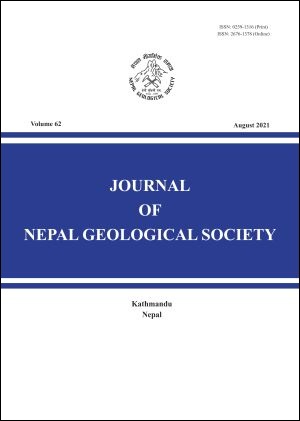Stability evaluation of hazardous translational slide zones in part of Yamunotri Pilgrimage route, National Highway 507, Uttarakhand, India
DOI:
https://doi.org/10.3126/jngs.v62i0.38698Keywords:
Rock Mass Rating, Slope Mass Rating, Kinematic Analysis, Factor of SafetyAbstract
Slope failure is a widespread phenomenon in Lesser Himalaya owing to its fragile tectonic settings, rugged topography, high relief, abruptly varying gentle to steep slopes and peculiar climatic conditions. Road development and urban expansion have further deteriorated the slope conditions. National Highway 507, a part of the pilgrimage route to Yamunotri in Uttarakhand, is one such route, experiencing hostility from frequent slope failure episodes that are causing havoc for villagers and pilgrims. In the present study, the four most hazardous translational slide zones in the 22 km stretch from Judo to Kandi village in the Yamunotri pilgrimage route has been identified, for detailed geotechnical investigation and slope stability assessment applying different approaches. The rock masses of this region are inherently weak owing to their closeness to Aglar fault and other joints and fractures. Rock mass classification systems are used to assess the stability and for estimating strength parameters, viz. cohesion and angle of internal friction, essential for the factor of safety determination. They are slightly varying due to the relatively homogeneous grain size distribution and mineralogical composition of rock masses. Kinematic Analysis differentiated the type of failure as planar or wedge and, accordingly, factor of safety is determined by limit equilibrium approach. The factor of safety, computed strength parameters, discontinuity and slope properties, varies from 5.9 to 1.1 in dry conditions while it reduces below unity as the saturation upsurges. It depicts stable conditions in dry conditions but water penetration and saturation along the cracks and discontinuities during rainfall make them unstable. Close vicinity with fault, steep slope, presence of joints and weathered lithology are dominating factors initiating the instability in route with further aggravation by rainfall, road widening and urban expansion.
Downloads
Downloads
Published
How to Cite
Issue
Section
License
© Nepal Geological Society




